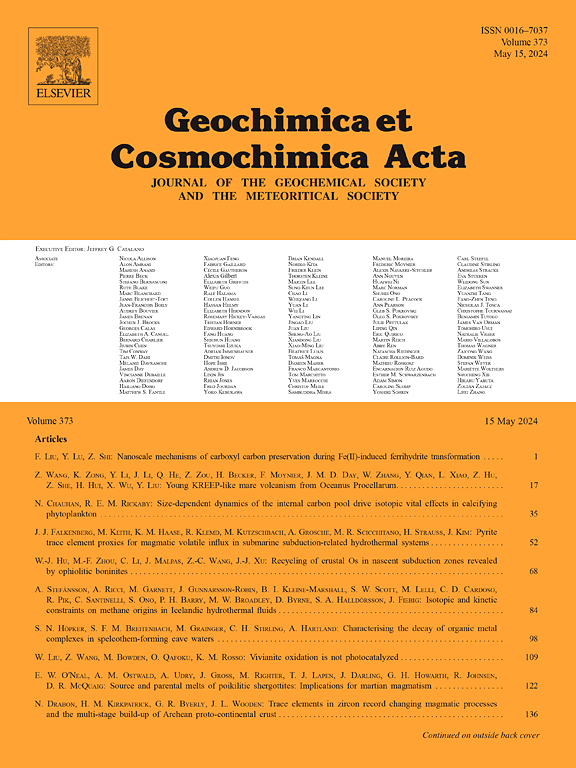Competitive incorporation of Ca, Sr, and Ba ions into amorphous carbonates
IF 4.5
1区 地球科学
Q1 GEOCHEMISTRY & GEOPHYSICS
引用次数: 0
Abstract
Amorphous alkaline earth carbonates typically occur as metastable precursors of widespread crystalline phases. Despite their transient nature, the properties of the amorphous carbonates affect the attributes of the crystalline end-products. The lack of long-range ordering in the amorphous solids allows for the incorporation of various ions into their structures, resulting in a wider range of cation compositions than in crystalline carbonate phases, furnishing these solids with peculiar physico-chemical properties. Here, we studied abiotic factors that could control the degree of incorporation of Ca2+, Sr2+, and Ba2+ cations into amorphous carbonates, and focused on the effects that different cation compositions have on the lifetimes and structures of amorphous solids, as well as on the structures of their crystalline end-products. The partition coefficients (DCa, DSr, and DBa) between the solution and the solid decreased with increasing ionic radius; however, in ternary systems the incorporation of Ba2+ was favored over Sr2+. Electron diffraction patterns and pair distribution functions calculated from them showed that incorporated Sr2+ and Ba2+ cations significantly modified the structural properties of the amorphous carbonates (relative to amorphous calcium carbonate). The changes in short-range structure resulted in exceptional kinetic stability of the ternary mixed amorphous Ca–Sr–Ba carbonates, with the lifetime of Sr0.1Ba.40Ca.50C 65 times longer than that of amorphous calcium carbonate. Ba2+ enhanced the formation of calcite-type structures, even in the presence of Sr2+. These findings contribute to the understanding of both the incorporation of alkaline earth metals into amorphous carbonates and their roles in prolonging the lifetimes of amorphous solids; in addition, our results can be potentially used for technological applications.
求助全文
约1分钟内获得全文
求助全文
来源期刊

Geochimica et Cosmochimica Acta
地学-地球化学与地球物理
CiteScore
9.60
自引率
14.00%
发文量
437
审稿时长
6 months
期刊介绍:
Geochimica et Cosmochimica Acta publishes research papers in a wide range of subjects in terrestrial geochemistry, meteoritics, and planetary geochemistry. The scope of the journal includes:
1). Physical chemistry of gases, aqueous solutions, glasses, and crystalline solids
2). Igneous and metamorphic petrology
3). Chemical processes in the atmosphere, hydrosphere, biosphere, and lithosphere of the Earth
4). Organic geochemistry
5). Isotope geochemistry
6). Meteoritics and meteorite impacts
7). Lunar science; and
8). Planetary geochemistry.
 求助内容:
求助内容: 应助结果提醒方式:
应助结果提醒方式:


